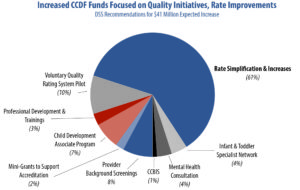View/Download the PDF Version
Access to high quality, affordable childcare not only creates a solid foundation for children to thrive but is essential to developing a strong workforce. Yet many Missouri families have difficulty accessing child care because of its high cost or lack of availability. Like other states, Missouri provides a Child Care Assistance Program, intended to help offset the costs of child care for working families with low wages. However, funding restrictions have reduced the benefits of Missouri’s program.
Increased federal funding through the Child Care Development Fund provides a critical opportunity for Missouri to improve its child care assistance program and increase access to quality care for Missouri kids by:
- Increasing eligibility for assistance, which is now among the lowest in the country, and
- Increasing provider reimbursement rates to promote quality and improve access.
Many families in Missouri struggle to pay for childcare. The cost of care for two children under age 5 at a child care center in Missouri is over $16,000 annually, accounting for over 70% of the income of the average single mother with two children.
While Missouri provides a Child Care Assistance Program, intended to offset the costs of child care for working families with low wages, eligibility for assistance in Missouri is among the most restrictive nationwide.
- Missouri’s eligibility limit for assistance ends at just 138% of the federal poverty level (the equivalent of an income of $2,389 per month for a family of three).
- This is well below the national average of 180% and lower than all neighboring states except Nebraska.
In addition to low eligibility levels, Missouri’s payment rates for child care providers who care for children through the subsidized child care program are among the lowest in the nation and well below market rates.
- In some cases, reimbursement is as low as 51% of the cost of care.
- Child care providers are allowed to charge most parents the difference between what the state pays and the actual cost of care, which can limit the number of children in their care who participate in the child care assistance program. Providers may also elect not to accept children with child care assistance at all.
Low eligibility for assistance, high out of pocket costs for parents, and inadequate reimbursement rates
contribute to a lack of access to quality childcare for Missouri’s working families.
Funding for Missouri’s Child Care Assistance Program
Child care assistance serves an average of 36,000 Missouri kids each month, and a total of 63,000 children each year.
The Missouri Child Care Assistance program is supported by a combination of state and federal funding, making it a partnership between the state and federal government. In fact, over three-fourths of the funding to support Missouri’s program is federal, with the Child Care Development Fund serving as the largest source of support.
Missouri Can Use Increased Federal Child Care Development Funding to Improve Eligibility and Reimbursement
Missouri expects to receive $41 million in increased federal funding through the Child Care Development Fund’s Congressional enhancements that can be used to bolster the child care assistance program in the 2019 and 2020 state budget years.
This additional funding provides a critical opportunity for Missouri to invest in improvements in eligibility, provider payment rate increases to increase access to care, and in quality improvements. In fact, state lawmakers already approved the use of $10 million of those funds in the current year budget (FY 2019) and directed those funds to quality improvements through enhanced trainings for providers and supports to assist providers with accreditation.
The Department of Social Services budget request suggested using 61% of the total increased funding for rate increases for providers, with the remainder being directed at quality improvements.
At the same time, the Department of Social Services is transitioning to an electronic time and reporting system for providers. That transition is expected to save up to $15 million annually, which could be reinvested to further bolster Missouri’s Child Care Assistance Program through increases in eligibility.
For each $750,000 in additional funding that the state invests, eligibility levels could be increased by one percentage point. So, a $15 million increase could lift Missouri’s very low eligibility cut-off of 138% FPL to 158% FPL – much closer to the national average.
Risks Due to Lingering State Budget Problems and TANF Reauthorization
In addition to the Child Care Development Fund, Missouri also relies on federal TANF (Temporary Assistance for Needy Families) funding and state General Revenue to support child care assistance. Dynamics at both the state and federal level place those two funding sources at risk, requiring advocacy among those who care about child care and early education.
Specifically, the United States Congress is beginning to consider reauthorization of TANF, which is expected to occur in 2019. A recent Congressional proposal for that reauthorization would have created new restrictions resulting in the loss of $100 million in federal TANF funding for Missouri – or nearly 50% of Missouri’s TANF funding. Though that proposal does not appear to be moving forward, Missouri child advocates will need to be vigilant in their review of additional TANF proposals in 2019.
At the same time, the continued implementation of the 2014 tax cuts in Missouri will make it more difficult each year to meet inflationary needs, and will continually place pressure on lawmakers to make reductions in services.



